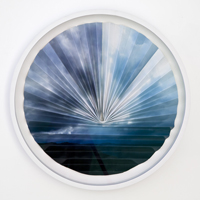Letha Wilson reaches some impressive heights, and why not? She did, after all, shape them herself, from plywood, museum board, and cement. Well, maybe not entirely, for each work entails actual photography, from a mythic American landscape. Wilson looks up close at rock faces and vegetation, from New England to the country of sagebrush and salt flats. She pulls back, too, for horizontal clouds above a slowly rising horizon. And then she adds her own.
The photograph comes first, at a gallery known for the medium, Higher Pictures through January 26. At its simplest, a storm cloud folds up like a fan, as it to promise relief from drier weather. More often, paper provided a mold, with photography later laid over or peeking through. Two mountains appear through neat circular holes in an apparent rock face, which owes its variations to four colors of poured concrete. Nothing at all appears where a smooth diagonal of wood once crossed another mold, but C prints layer the irregular surface without creasing. The fictive landscape might have evolved in geologic time.
Titles like Photogram New York (Colorado) or Salt Flats Cement Dip instantly announce a hybrid. Copper Pink Sand Dunes does so more subtly, since the copper pink refers to a sharp dab of paint. Yet the titles also imply displacement—a work not entirely at home outdoors or in. It says something that one has cliffs up close and peaks at a distance, but nothing in between. Displacement may simply go with the territory for the Badlands of outlaws. Here, though, an artist had to create it.
For an American, not to mention an American artist, there is always something defining about the great outdoors. There is also something hard to live up to. This is, after all, the Maine of Winslow Homer and the west of the Hudson River School after it passed beyond the Hudson—where even a cement dip shares takes on the translucency of light and sky. Photograms, here again pierced by flaps and photos, go back to Man Ray and Surrealism. The media also draw on both collage and Minimalism, like a slim column with the Grand Tetons sticking out from either side. The photos take on the physical heft of what they represent.
At least one can imagine that they do, while stepping up to inspect the damage. Wilson echoes a common theme in politics and photography, much as whenRichard Misrach encountered lunch tables on salt flats: disturbance of the land colors American, environmental, or human history—and a contested history at that. Wilson’s hybrids also suggest how, for many, the very idea of nature is always a human construction. A few years back in Socrates Sculpture Park, she built on minimalist geometry to stage the ideal of a community garden. Now the image itself stakes out a physical terrain.
The environment sure looks more natural than in the gallery’s previous show, through December 8. It also looks far more human. Lynne Cohen photographed offices and community centers, from 1971 to 1988, but with no hint of employment or community. She found walls lined with birds, clouds, and moose heads, but they chased out the people long ago. More often than not, even during a war game (Play at Your Own . . .), one can hardly put one’s finger on just what is out of place. Maybe that is because, for once in photography, it is the world that almost everyone knows all too well.

